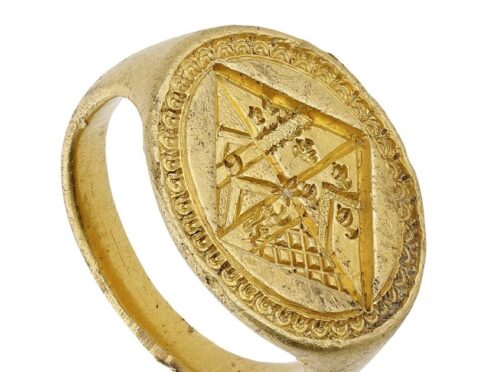
A gold ring found by a metal detectorist in a field in Norfolk is expected to fetch more than £14,000 at auction.
Retired carpenter Alan Rumsby unearthed the jewellery, that was buried at a depth of nine inches, in Roydon near Diss in Norfolk.
The 75-year-old had searched the area several times without success before making the discovery in October 2020.
It is thought that the ring, which bears a coat of arms, was once owned by a woman who was born in the 16th century.
Nigel Mills, artefact and coin expert at auctioneers Noonans, said: “The ring is historically important because it is extremely rare to find a seal ring of this period that was worn by a woman.
“This is indicated using a lozenge-shaped coat of arms on the bezel of the ring.

“The arms are divided into four, each representing her ancestral family heritage, namely Ashfield; Tendring; Botelier and finally Mapersall.
“The five-pointed star in the centre of the arms represents a third son so we believe the ring was owned by Dorothy Ashfield who was born in 1594, the eldest daughter of the third son Thomas Ashfield of Hopton in Suffolk and his wife Ellen Holditch of Ranworth in Norfolk.”
He said the site where the ring was found was “close to the old hall of Brockdish which was owned by John Tendring whose family arms appears on the second quadrant of the ring bezel as a fess (horizontal band) with a crescent between two chevrons”.
“The name Ashfield originates in Suffolk and Shropshire, meaning a field with ash trees,” he added.
Mr Rumsby said he was “excited” to find the ring and hoped its sale would pay for a holiday.
“I have never found anything made of gold in over 10 years of detecting so was really excited,” he said.

“It was only after it was taken to the museum that I realised how significant this discovery was.
“The British Museum had originally declared an interest in acquiring the ring but now two years later the ring has been disclaimed, so I am able to sell it.
“I intend to use the money, which will be shared with the landowner, on a holiday for my wife and myself.”
The ring is to be offered for sale at Noonans Mayfair in London in a sale of jewellery, watches, silver and objects of vertu on Tuesday March 12.
It has a pre-auction estimate of £14,000 to £16,000.

Enjoy the convenience of having The Sunday Post delivered as a digital ePaper straight to your smartphone, tablet or computer.
Subscribe for only £5.49 a month and enjoy all the benefits of the printed paper as a digital replica.
Subscribe